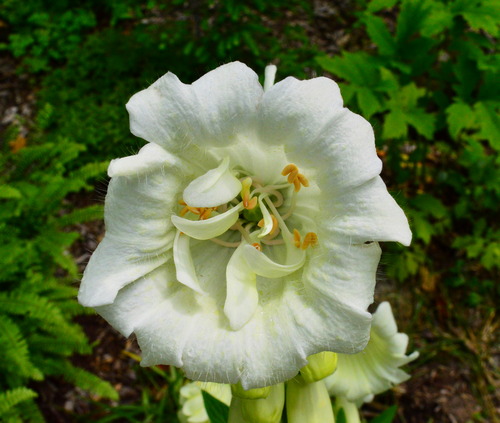Plant of the Month for July, 2019

(dig-ee-TAH-liss pur-PUR-ee-uh)
General Information:
I walked outside a few days ago and immediately spotted my monster foxglove. It is a cream yellow, growing in a fairly shady spot where the color just glows. But what made it really stand out is the large uncharacteristic flower at the top of the inflorescence (flower stem). It was a rare peloric mutation.
The formation of peloric flowers in foxgloves is fairly rare but they have been report for many years. The proper botanical name for this plant is Digitalis purpurea monstrosa. The term monstrosa is Greek and means huge or monsterous.

Digitalis purpurea monstrosa (peloric flower): photo by Robert Pavlis
A normal foxglove develops an indeterminate inflorescence that steadily gets taller until the plant can't support more flowers. The flowers open sequentially starting at the bottom. In a peloric foxglove, a terminal flower develops and opens before any of the other buds. This stops any further growth above the peloric flower. The remaining flowers open from the bottom up and have a normal shape.
A normal foxglove flower has bilateral symmetry, where the left side mirrors the right side through a vertical axis. The peloric flower shows radial symmetry. You can draw any number of axis through the flower and the two halves mirrors each other, provided that the flower developed properly.
Pelorism is normally found in plants that have a bilateral symmetry, such as gloxinia, orchid, snapdragon, Pelargonium, Primula auricula and members of the mint family.
The genetics of peloric foxgloves was deciphered a hundred years ago. It is controlled by a simple Mendelian recessive gene. If you cross a peloric plant with itself, all of offspring will be peloric. If this plant is crossed with a fully normal plant, all of the F1 offspring (first generation) will look normal, but will carry the recessive gene, which is expressed in the F2 generation.

Digitalis purpurea monstrosa (peloric flower): photo by Robert Pavlis
The expression of the gene is a bit more complicated than that because peloric plants don't always form the top peloric flower, in which case they look quite normal. It is not clear what causes the expression of the gene, but the environment is referenced by several people. It could be a decrease in light, or unusual temperatures, indicating an epigenetic effect.
All of the flowers on a peloric plant, including the top one, will produce seed that contains the recessive gene.
So where did my plant come from? I had been growing some hybrid D. purpurea nearby but since they are biennial and I mulch heavily, foxgloves tend not to self sow very much. A few did flower in the same spot as the peloric one, but they did not show pelorism, nor were they a creamy yellow color with almost no spotting.
D. lutea, a reliable perennial in my garden also flowers close by. It is yellow, but much smaller in size. I also grow D. lanata and D. grandiflora on the other side of the house. Cross pollination was certainly possible.
This year, the plant in the picture is the only D. purpurea that is flowering in the garden so cross pollination is not likely within the species.
The subject plant has made four flowering stems so far, and each is topped with a peloric flower. It is the only fully yellow one that I found on the internet.
This is the first peloric plant I have seen in the garden, and the weather this year has been very unusual. It has been very cold and wet. It is middle June, and normal late spring weather has still not arrived, causing many plants to behave differently this year.
Life Cycle: biennial
Height: 90cm (3 ft)
Bloom Time: summer
Natural Range: Europe
Habitat: woodland clearings, disturbed soil
Synonyms: none
Cultivation:
Light: sun to part shade
Soil: average
Water: average to dry
USDA Hardiness Zone: 4- 8
Propagation: seed
Seedex availability (ORG&HPS annual Seed Exchange): rare
